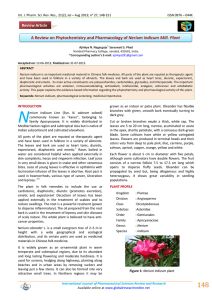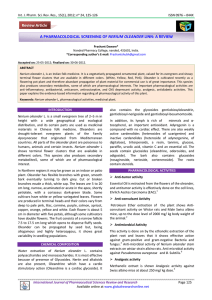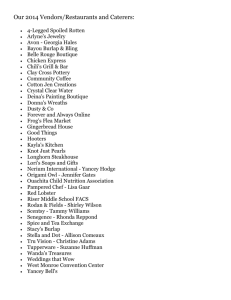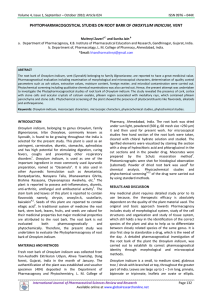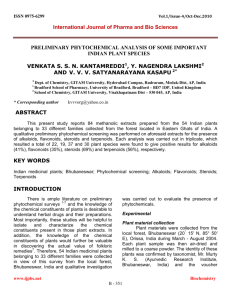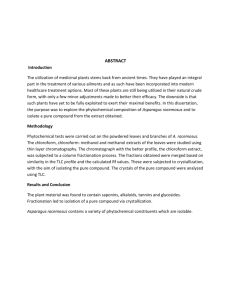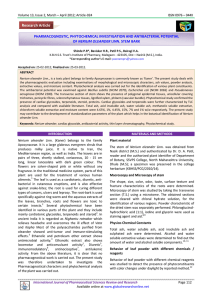Document 13309406
advertisement
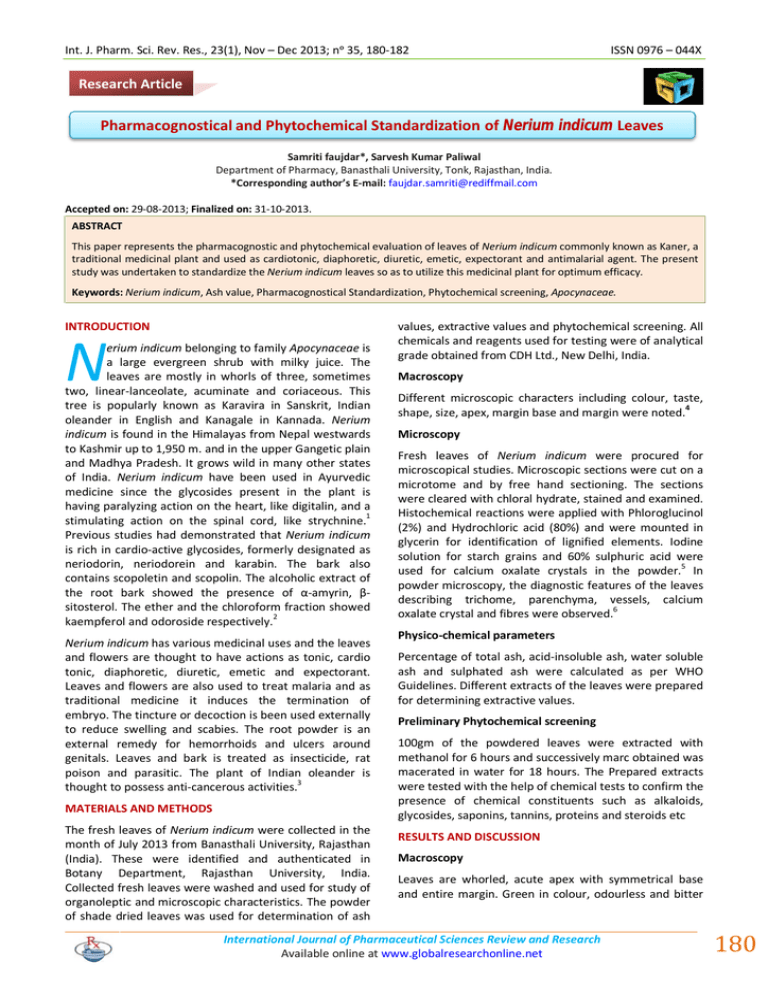
Int. J. Pharm. Sci. Rev. Res., 23(1), Nov – Dec 2013; nᵒ 35, 180-182 ISSN 0976 – 044X Research Article Pharmacognostical and Phytochemical Standardization of Nerium indicum Leaves Samriti faujdar*, Sarvesh Kumar Paliwal Department of Pharmacy, Banasthali University, Tonk, Rajasthan, India. *Corresponding author’s E-mail: faujdar.samriti@rediffmail.com Accepted on: 29-08-2013; Finalized on: 31-10-2013. ABSTRACT This paper represents the pharmacognostic and phytochemical evaluation of leaves of Nerium indicum commonly known as Kaner, a traditional medicinal plant and used as cardiotonic, diaphoretic, diuretic, emetic, expectorant and antimalarial agent. The present study was undertaken to standardize the Nerium indicum leaves so as to utilize this medicinal plant for optimum efficacy. Keywords: Nerium indicum, Ash value, Pharmacognostical Standardization, Phytochemical screening, Apocynaceae. INTRODUCTION N erium indicum belonging to family Apocynaceae is a large evergreen shrub with milky juice. The leaves are mostly in whorls of three, sometimes two, linear-lanceolate, acuminate and coriaceous. This tree is popularly known as Karavira in Sanskrit, Indian oleander in English and Kanagale in Kannada. Nerium indicum is found in the Himalayas from Nepal westwards to Kashmir up to 1,950 m. and in the upper Gangetic plain and Madhya Pradesh. It grows wild in many other states of India. Nerium indicum have been used in Ayurvedic medicine since the glycosides present in the plant is having paralyzing action on the heart, like digitalin, and a stimulating action on the spinal cord, like strychnine.1 Previous studies had demonstrated that Nerium indicum is rich in cardio-active glycosides, formerly designated as neriodorin, neriodorein and karabin. The bark also contains scopoletin and scopolin. The alcoholic extract of the root bark showed the presence of α-amyrin, βsitosterol. The ether and the chloroform fraction showed kaempferol and odoroside respectively.2 Nerium indicum has various medicinal uses and the leaves and flowers are thought to have actions as tonic, cardio tonic, diaphoretic, diuretic, emetic and expectorant. Leaves and flowers are also used to treat malaria and as traditional medicine it induces the termination of embryo. The tincture or decoction is been used externally to reduce swelling and scabies. The root powder is an external remedy for hemorrhoids and ulcers around genitals. Leaves and bark is treated as insecticide, rat poison and parasitic. The plant of Indian oleander is thought to possess anti-cancerous activities.3 MATERIALS AND METHODS The fresh leaves of Nerium indicum were collected in the month of July 2013 from Banasthali University, Rajasthan (India). These were identified and authenticated in Botany Department, Rajasthan University, India. Collected fresh leaves were washed and used for study of organoleptic and microscopic characteristics. The powder of shade dried leaves was used for determination of ash values, extractive values and phytochemical screening. All chemicals and reagents used for testing were of analytical grade obtained from CDH Ltd., New Delhi, India. Macroscopy Different microscopic characters including colour, taste, shape, size, apex, margin base and margin were noted.4 Microscopy Fresh leaves of Nerium indicum were procured for microscopical studies. Microscopic sections were cut on a microtome and by free hand sectioning. The sections were cleared with chloral hydrate, stained and examined. Histochemical reactions were applied with Phloroglucinol (2%) and Hydrochloric acid (80%) and were mounted in glycerin for identification of lignified elements. Iodine solution for starch grains and 60% sulphuric acid were used for calcium oxalate crystals in the powder.5 In powder microscopy, the diagnostic features of the leaves describing trichome, parenchyma, vessels, calcium oxalate crystal and fibres were observed.6 Physico-chemical parameters Percentage of total ash, acid-insoluble ash, water soluble ash and sulphated ash were calculated as per WHO Guidelines. Different extracts of the leaves were prepared for determining extractive values. Preliminary Phytochemical screening 100gm of the powdered leaves were extracted with methanol for 6 hours and successively marc obtained was macerated in water for 18 hours. The Prepared extracts were tested with the help of chemical tests to confirm the presence of chemical constituents such as alkaloids, glycosides, saponins, tannins, proteins and steroids etc RESULTS AND DISCUSSION Macroscopy Leaves are whorled, acute apex with symmetrical base and entire margin. Green in colour, odourless and bitter International Journal of Pharmaceutical Sciences Review and Research Available online at www.globalresearchonline.net 180 Int. J. Pharm. Sci. Rev. Res., 23(1), Nov – Dec 2013; nᵒ 35, 180-182 in taste with 3-22cm in length and 0.5-2.2 cm in width with Parallel venation. Transverse Section of leaf ISSN 0976 – 044X nature. Epidermis showed parenchymatous cells wavy walled with diacytic type of stomata and fibres were long, slender and cylindrical in shape. T.S. of the leaf showed following characters. The outer portion is upper epidermis which revealed the presence of unicellular covering trichomes. Below the epidermis, collenchymas (4-5 layered) and elongated cells of palisade parenchyma were observed. Calcium oxalate cells were present in the spongy parenchyma. The midrib consisted of vascular bundles namely xylem and phloem. 3-4 layered parenchymatous cells with intercellular spaces were present below the vascular bundle. Below the parenchymatous and above the lower epidermis collenchymatous cells were observed. Powder Microscopy The powder microscopy showed pyramidal shaped calcium oxalate crystals. Trichomes were unicellular uniseriate and glandular, vessels were annual to spiral in Figure 1: Transverse Section of Nerium indicum Leaf Figure 2: Powder characteristics of Nerium Indicum Leaf International Journal of Pharmaceutical Sciences Review and Research Available online at www.globalresearchonline.net 181 Int. J. Pharm. Sci. Rev. Res., 23(1), Nov – Dec 2013; nᵒ 35, 180-182 Physicochemical Parameters Powdered drug was evaluated for different standardization parameters and results were shown in table 1. Table 1: Physical evaluation of Nerium indicum Leaves Parameter Results Total Ash Acid insoluble ash Water Soluble ash Water Soluble Extractive value Alcohol Soluble Extractive Value Loss on Drying 10% w/w 5.75%w/w 2.73%w/w 10.74%w/v 9.2%w/v 0.4%w/w ISSN 0976 – 044X The pharmcognostical and phytochemical study is a criterion for correct identification of crude drugs. These will provide us the knowledge of any adulteration if present with the drug which reduces the efficacy of the drug. CONCLUSION The present study will provides us the standards for correct identification of Nerium indicum leaves on the basis of microscopical characteristics, physical evaluation and chemical analysis. The preliminary phytochemical screening will further help in isolation of important compounds in future. REFERENCES Preliminary Phytochemical screening 1. The aqueous and methanolic extracts were subjected to preliminary phytochemical screening. The results were shown in table 2. www.himalayahealthcare.com/herbfinder/h_nerium. htm 2. Randhawa GS, Mukhopadhyaym A, Floriculture in India, Allied Publishers, 1986, 158. Table 2: Preliminary Phytochemical screening 3. www.spicesmedicinalherbs.com/neriumindicum.html 4. Evans WC, Trease and Evans Pharmacognosy, Edn. 15th, Philadelphia Elsevier Science Ltd., New Delhi, 2006, 513-547. 5. Kokate C, Purohit A, Gokhle S, Practical Pharmacognosy, Vallabh Prakashan, New Delhi, Tenth Edition, 1994, 112-120. 6. Fahn A, Plant Anatomy, Ed. 3rd. Pergamon Press, Oxford, 1997, 513-530. 7. Harborne JB, Phytochemical Methods, Ed. 3rd. Chapman and Hall, London, 1998, 218. Chemical constituents Alkaloids Glycosides Carbohydrates Saponins Flavonoids Tannins and Phenolic compounds Steroids Amino acids Methanolic extract Aqueous extract + + + + + + + + + - + - Source of Support: Nil, Conflict of Interest: None. International Journal of Pharmaceutical Sciences Review and Research Available online at www.globalresearchonline.net 182
